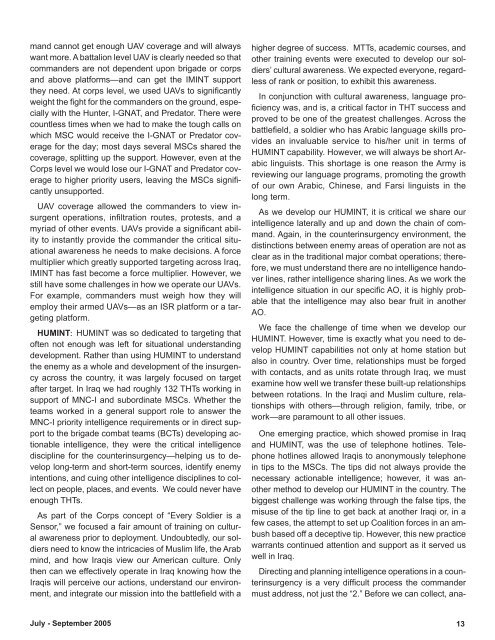Military Intelligence Professional Bulletin - Federation of American ...
Military Intelligence Professional Bulletin - Federation of American ...
Military Intelligence Professional Bulletin - Federation of American ...
Create successful ePaper yourself
Turn your PDF publications into a flip-book with our unique Google optimized e-Paper software.
mand cannot get enough UAV coverage and will always<br />
want more. A battalion level UAV is clearly needed so that<br />
commanders are not dependent upon brigade or corps<br />
and above platforms—and can get the IMINT support<br />
they need. At corps level, we used UAVs to significantly<br />
weight the fight for the commanders on the ground, especially<br />
with the Hunter, I-GNAT, and Predator. There were<br />
countless times when we had to make the tough calls on<br />
which MSC would receive the I-GNAT or Predator coverage<br />
for the day; most days several MSCs shared the<br />
coverage, splitting up the support. However, even at the<br />
Corps level we would lose our I-GNAT and Predator coverage<br />
to higher priority users, leaving the MSCs significantly<br />
unsupported.<br />
UAV coverage allowed the commanders to view insurgent<br />
operations, infiltration routes, protests, and a<br />
myriad <strong>of</strong> other events. UAVs provide a significant ability<br />
to instantly provide the commander the critical situational<br />
awareness he needs to make decisions. A force<br />
multiplier which greatly supported targeting across Iraq,<br />
IMINT has fast become a force multiplier. However, we<br />
still have some challenges in how we operate our UAVs.<br />
For example, commanders must weigh how they will<br />
employ their armed UAVs—as an ISR platform or a targeting<br />
platform.<br />
HUMINT: HUMINT was so dedicated to targeting that<br />
<strong>of</strong>ten not enough was left for situational understanding<br />
development. Rather than using HUMINT to understand<br />
the enemy as a whole and development <strong>of</strong> the insurgency<br />
across the country, it was largely focused on target<br />
after target. In Iraq we had roughly 132 THTs working in<br />
support <strong>of</strong> MNC-I and subordinate MSCs. Whether the<br />
teams worked in a general support role to answer the<br />
MNC-I priority intelligence requirements or in direct support<br />
to the brigade combat teams (BCTs) developing actionable<br />
intelligence, they were the critical intelligence<br />
discipline for the counterinsurgency—helping us to develop<br />
long-term and short-term sources, identify enemy<br />
intentions, and cuing other intelligence disciplines to collect<br />
on people, places, and events. We could never have<br />
enough THTs.<br />
As part <strong>of</strong> the Corps concept <strong>of</strong> “Every Soldier is a<br />
Sensor,” we focused a fair amount <strong>of</strong> training on cultural<br />
awareness prior to deployment. Undoubtedly, our soldiers<br />
need to know the intricacies <strong>of</strong> Muslim life, the Arab<br />
mind, and how Iraqis view our <strong>American</strong> culture. Only<br />
then can we effectively operate in Iraq knowing how the<br />
Iraqis will perceive our actions, understand our environment,<br />
and integrate our mission into the battlefield with a<br />
higher degree <strong>of</strong> success. MTTs, academic courses, and<br />
other training events were executed to develop our soldiers’<br />
cultural awareness. We expected everyone, regardless<br />
<strong>of</strong> rank or position, to exhibit this awareness.<br />
In conjunction with cultural awareness, language pr<strong>of</strong>iciency<br />
was, and is, a critical factor in THT success and<br />
proved to be one <strong>of</strong> the greatest challenges. Across the<br />
battlefield, a soldier who has Arabic language skills provides<br />
an invaluable service to his/her unit in terms <strong>of</strong><br />
HUMINT capability. However, we will always be short Arabic<br />
linguists. This shortage is one reason the Army is<br />
reviewing our language programs, promoting the growth<br />
<strong>of</strong> our own Arabic, Chinese, and Farsi linguists in the<br />
long term.<br />
As we develop our HUMINT, it is critical we share our<br />
intelligence laterally and up and down the chain <strong>of</strong> command.<br />
Again, in the counterinsurgency environment, the<br />
distinctions between enemy areas <strong>of</strong> operation are not as<br />
clear as in the traditional major combat operations; therefore,<br />
we must understand there are no intelligence handover<br />
lines, rather intelligence sharing lines. As we work the<br />
intelligence situation in our specific AO, it is highly probable<br />
that the intelligence may also bear fruit in another<br />
AO.<br />
We face the challenge <strong>of</strong> time when we develop our<br />
HUMINT. However, time is exactly what you need to develop<br />
HUMINT capabilities not only at home station but<br />
also in country. Over time, relationships must be forged<br />
with contacts, and as units rotate through Iraq, we must<br />
examine how well we transfer these built-up relationships<br />
between rotations. In the Iraqi and Muslim culture, relationships<br />
with others—through religion, family, tribe, or<br />
work—are paramount to all other issues.<br />
One emerging practice, which showed promise in Iraq<br />
and HUMINT, was the use <strong>of</strong> telephone hotlines. Telephone<br />
hotlines allowed Iraqis to anonymously telephone<br />
in tips to the MSCs. The tips did not always provide the<br />
necessary actionable intelligence; however, it was another<br />
method to develop our HUMINT in the country. The<br />
biggest challenge was working through the false tips, the<br />
misuse <strong>of</strong> the tip line to get back at another Iraqi or, in a<br />
few cases, the attempt to set up Coalition forces in an ambush<br />
based <strong>of</strong>f a deceptive tip. However, this new practice<br />
warrants continued attention and support as it served us<br />
well in Iraq.<br />
Directing and planning intelligence operations in a counterinsurgency<br />
is a very difficult process the commander<br />
must address, not just the “2.” Before we can collect, ana-<br />
July - September 2005 13
















